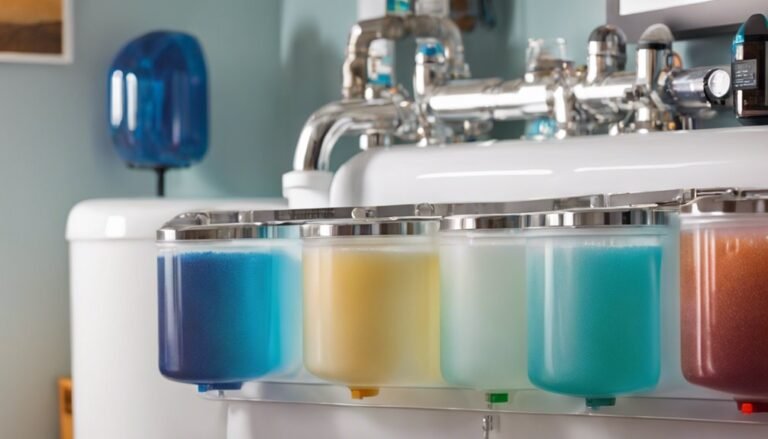How to Use a Water Softner
Imagine you've just moved into a home with hard water, and you notice your dishes are always spotted and your skin feels dry after showering. You might be considering how to effectively use a water softener to improve your water quality. First, you'll need to understand the basics of setting it up and maintaining it properly. However, there are several key steps and tips that can make a significant difference in how well your system functions and ultimately impacts your daily life.
Key Takeaways
- Test your water hardness level to select the appropriate water softener for your needs.
- Install the water softener near the main water supply and drainage, following manufacturer instructions.
- Regularly check the salt level in the brine tank and maintain it at about 1/3rd full for optimal performance.
- Familiarize yourself with control settings, including regeneration cycles, and adjust based on water usage and quality.
- Perform routine maintenance, including cleaning the brine tank and inspecting for leaks or issues, to ensure long-term efficiency.
Understanding Water Hardness
Understanding water hardness is vital for maintaining your home's plumbing and appliances. Water hardness refers to the concentration of minerals, mainly calcium and magnesium, in your water supply. The hardness levels can range from soft to very hard, affecting everything from your skin and hair to the efficiency of your water heater and dishwasher.
When you're dealing with hard water, you might notice scale buildup in pipes and appliances, which can lead to costly repairs. It's important to identify the hardness levels in your water, as this can help you make informed decisions about treatment options. You can measure water hardness using test strips or kits available at home improvement stores.
Soft water, with lower hardness levels, is often more desirable because it lathers easily with soap and detergents, helping to prevent residue buildup.
Understanding the implications of water hardness not only aids in extending the lifespan of your plumbing but also improves overall water quality. By recognizing the specific hardness levels in your home, you can take proactive steps to guarantee your plumbing and appliances work efficiently. This knowledge ultimately empowers you to make better choices for your household.
Choosing the Right Water Softener
Knowing your water hardness can help you choose the right water softener for your home. Start by testing your water to determine its hardness level, typically measured in grains per gallon (GPG).
Once you know your hardness level, you can explore the various types of water softeners available. The most common types include salt-based, salt-free, and dual-tank systems, each catering to different needs and preferences.
When selecting a water softener, pay attention to water softener ratings. These ratings provide valuable insights into the efficiency, capacity, and performance of each model. For example, if you have a larger household, you'll want a unit with a higher capacity to guarantee it meets your water demands. Conversely, if you're in a smaller space, a compact model may suffice.
Don't forget to take into account maintenance requirements as well. Some systems require regular salt refills, while others are low-maintenance.
Installation Process
Installing a water softener might seem intimidating, but with the right tools and materials, you can tackle it with confidence.
We'll walk you through a step-by-step setup process and highlight common installation mistakes to avoid.
Required Tools and Materials
To successfully install a water softener, you'll need a few essential tools and materials. Start with your tools checklist, which should include a wrench, pliers, a screwdriver, and a level. These basic tools will help you with the plumbing connections and adjustments necessary for your softener.
Next, gather your essential materials. You'll need Teflon tape for sealing connections, a bypass valve (if it isn't included with your softener), and a water softener installation kit. This kit often contains fittings, tubing, and other components specific to your model.
Don't forget to have a bucket handy for any water spills during the installation process. If your water softener requires a drain line, make sure to have a hose or pipe suitable for drainage.
Finally, consider having some salt on hand, as you'll need it to start the softening process once the installation is complete. By preparing this tools checklist and gathering your essential materials ahead of time, you'll streamline the installation process, making it a lot easier and more efficient.
Step-by-Step Setup
With your tools and materials ready, you can plunge into the step-by-step setup of your water softener. This process not only improves your water quality but also guarantees your plumbing system runs efficiently. Follow these instructions closely to get started:
- Locate the installation site: Choose a spot near your water supply line and a drain for backwashing.
- Turn off the water supply: Shut off the main valve before you begin any plumbing basics.
- Install the bypass valve: Connect it to the incoming water line to allow for easy maintenance.
- Connect the softener: Attach the inlet and outlet pipes, making sure they're secure to prevent leaks.
- Add salt to the brine tank: Fill it with the appropriate type of salt, following the manufacturer's guidelines.
Once everything's connected, turn the water supply back on and check for any leaks.
It's essential to understand the basics of plumbing during this setup, as it makes the process smoother.
After installation, run a test on your water to confirm that the softener is functioning properly.
Enjoy the benefits of softer water and a well-maintained plumbing system!
Common Installation Mistakes
Many homeowners occasionally overlook key details during the installation of a water softener, which can lead to costly mistakes. One of the common pitfalls isn't reading the manufacturer's instructions thoroughly. These guidelines provide essential installation tips that can save you time and money.
Another mistake is improper plumbing connections. Make sure that you connect the inlet and outlet pipes correctly; otherwise, you might end up with water flow issues.
Furthermore, failing to check for leaks after installation can result in water damage and increased utility bills.
You should also avoid skipping the pre-installation steps, like measuring your space. If your water softener doesn't fit, you'll face unnecessary frustration.
In addition, neglecting to adjust the settings for your specific water hardness can lead to ineffective softening.
Lastly, don't forget to take into account the drainage requirements for your system. Improper drainage can cause backups and malfunctions.
By being mindful of these common installation mistakes, you'll guarantee a smoother setup process and enjoy the benefits of softened water without unnecessary headaches.
Setting Up Your Water Softener
Before you start enjoying the benefits of softened water, you'll need to set up your water softener correctly. This vital step guarantees ideal water quality and system efficiency. Here's how to get started:
- Select the right location: Choose a dry area near your main water line, ideally close to the water heater.
- Connect your inlet and outlet pipes: Follow the manufacturer's instructions to guarantee a secure fit.
- Install a drain line: This is necessary for removing the brine solution during regeneration.
- Add salt to the brine tank: Use high-quality water softener salt to enhance performance and longevity.
- Program the timer: Set the regeneration cycle according to your water usage, which helps maintain system efficiency.
Operating the Water Softener
Operating a water softener is straightforward, and following a few key steps will keep it running efficiently.
First, familiarize yourself with the control settings on your unit. These typically include options for regeneration cycles, which determine when the softener cleans itself. You'll want to adjust these settings based on your household's water usage and hardness levels.
Next, employ effective operating techniques. Regularly check the salt levels in the brine tank. If the salt is low, your softener won't function properly, and hard water will start creeping back into your home. It's usually best to maintain a salt level of about 1/3rd full.
Also, monitor your water usage to gauge how often your softener needs to regenerate. If you notice a decline in water quality, it may be time to adjust your control settings or schedule more frequent regenerations.
Finally, keep an eye on any warning lights or alerts on the softener. Address these promptly to guarantee your water softener continues to operate effectively.
Routine Maintenance Tips
Maintaining your water softener is key to its long-term performance and efficiency. Regular checks and maintenance guarantee that your unit operates smoothly, providing you with soft water when you need it.
Here are some essential routine maintenance tips you should follow:
- Check salt levels: Make it a habit to inspect your salt levels every month. Keeping the salt tank full helps the softener function properly.
- Clean the brine tank: Periodically clean the brine tank to remove any salt buildup or debris, ensuring peak operation.
- Monitor resin cleaning: Schedule resin cleaning every few years to maintain the resin beads that soften the water. This process helps restore their effectiveness.
- Inspect the system for leaks: Regularly check for leaks or signs of wear around the unit. Early detection can save you from costly repairs.
- Replace filters: If your water softener has filters, make sure to replace them according to the manufacturer's recommendations to maintain water quality.
Troubleshooting Common Issues
If you're experiencing low water pressure or suspect a salt bridge has formed in your water softener, don't worry—you're not alone.
These common issues can be frustrating, but they're usually easy to fix with a little troubleshooting.
Let's explore how to identify and resolve these problems to keep your water softener running smoothly.
Low Water Pressure
Experiencing low water pressure in your home can be frustrating, especially when you rely on a water softener for peak performance. Low pressure can affect your daily routines, from showering to washing dishes. Understanding low pressure causes is essential for fixing pressure issues effectively.
Here are some common causes of low water pressure:
- Clogged filters: Over time, softener filters can accumulate debris, leading to restricted flow.
- Faulty pressure regulator: A malfunctioning regulator may not maintain the right pressure in your system.
- Leaks in plumbing: Hidden leaks can divert water and reduce overall pressure.
- Incorrectly sized pipes: Using pipes that are too small for your home's needs can limit water flow.
- Water softener settings: Incorrect settings could restrict water flow during regeneration cycles.
To fix low water pressure, start by checking these potential issues. Regular maintenance of your water softener and plumbing will help guarantee ideal performance.
If you've tried these solutions and pressure remains low, consider consulting a professional to identify more complex problems. Keeping your water pressure in check guarantees your water softener works efficiently and effectively.
Salt Bridge Formation
Low water pressure can sometimes lead to issues with your water softener, one of which is salt bridge formation. A salt bridge occurs when salt crystals harden in the brine tank, creating a barrier that prevents the softener from regenerating properly. If you notice that your water isn't as soft as it should be, a salt bridge might be the culprit.
To troubleshoot this issue, start by inspecting the brine tank. If you see a solid mass of salt, you'll need to break it up. You can do this by gently tapping the side of the tank or using a long object to break apart the bridge. After breaking it up, add some hot water to dissolve the remaining salt.
Prevention methods are key to avoiding future salt bridges. Make certain to regularly check the salt level and add salt as needed, keeping it at least half full.
Use high-quality salt, as impurities can contribute to build-up. Furthermore, maintaining consistent water pressure can help keep the salt flowing properly, reducing the likelihood of a salt bridge forming.
Benefits of Soft Water
Soft water offers numerous benefits that can enhance your daily life. When you switch to soft water, you'll notice significant improvements in various aspects of your home and personal care. Here are some key advantages:
- Improved skin: Soft water can help reduce dryness and irritation, leaving your skin feeling softer and healthier.
- Appliance longevity: By reducing mineral buildup, soft water can extend the life of your appliances, saving you money on repairs and replacements.
- Better cleaning: With soft water, you'll find that soaps and detergents lather more effectively, making your cleaning tasks easier and more efficient.
- Softer laundry: Your clothes will feel softer and look brighter since soft water prevents mineral deposits that can dull fabrics.
- Reduced plumbing issues: Soft water minimizes scale buildup in pipes, which can lead to costly plumbing repairs.
Embracing soft water not only enhances your daily routines but also contributes to a healthier home environment.
You'll enjoy the benefits of improved skin, longer-lasting appliances, and a more efficient cleaning process—all while making your life a little easier.
Consider making the switch today!
Frequently Asked Questions
How Do I Know if My Water Softener Is Working Properly?
To know if your water softener's working properly, test your water regularly. Check the hardness levels; if they're low, your system's effective. If not, it might need maintenance or salt replacement to function correctly.
Can I Use Softened Water for Gardening?
Imagine your plants basking in a gentle rain. You can use softened water for gardening; it reduces mineral buildup in soil, promoting growth. Just remember to follow gardening tips for best results! Your plants will thrive.
Will a Water Softener Affect My Drinking Water?
A water softener can affect your drinking water quality. It may change the softened water taste, making it saltier. If you're concerned, consider using a separate tap for unsoftened water for drinking and cooking.
How Often Should I Replace the Resin in My Water Softener?
You should replace the resin in your water softener every 5 to 10 years, depending on usage. Regular resin maintenance guarantees peak performance, while understanding resin lifespan helps you plan for timely replacements and avoid issues.
What's the Difference Between Salt-Based and Salt-Free Water Softeners?
Ever wonder how your water softener choice impacts your home? Salt-based systems offer great benefits, like effective hardness removal, while salt-free options provide advantages like lower maintenance and less sodium. Choose what fits your lifestyle best!
Conclusion
Incorporating a water softener into your home may seem like a hassle, but the benefits far outweigh any initial effort. You'll enjoy softer skin, cleaner dishes, and longer-lasting appliances. By following the straightforward steps of testing water hardness, selecting the right unit, and maintaining it regularly, you can guarantee peak performance. Don't let hard water take a toll on your home; embrace the ease and comfort of softened water for a healthier, more efficient lifestyle.







